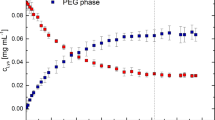Abstract
It has previously been shown that a droplet fractionation process, simulated by shaking a separatory funnel containing a dilute protein solution, can generate droplets richer in protein than present in the original dilute solution. In this article, we describe an alternative method that can increase the amount of protein transferred to the droplets. The new metho uses ultrasonic waves, enhanced by a bubble gas stream to create the droplets. The amount of protein in these droplets increases by about 50%. In this method, the top layer of the dilute protein solution (of the solution-air interface) becomes enriched in protein when air is bubbled into the solution. This concentrating procedure is called bubble fractionation. Once the protein has passed through the initial buildup, this enriched protein layer is transferred into droplets with the aid of a vacuum above the solution at the same time that ultrasonic waves are introduced. The droplets are then carried over to a condenser and coalesced. We found that this new method provides an easier way to remove the protein-enriched top layer of the dilute solution and generates more droplet within a shorter period than the separatory funnel droplet generation method. The added air creates the bubbles and carries the droplets, and the vacuum helps remove the effluent airstream from the condenser. The maximum partition coefficient, the ratio of the protein concentration in the droplets to that in the residual solution (approx 8.5), occurred at pH 5.0.
Similar content being viewed by others
References
Karger, B. L., Snyder, L. R., and Horvath, C. (1973), An Introduction to Separation Science, John Wiley & Sons, New York, pp. 423–436.
Ko, S., Loha, V., Du, L., Prokop, A., and Tanner, R. D. (1999), Appl. Biochem. Biotechnol. 77/79, 501–510.
Kokitkar, P. B. and Tanner, R. D. (1991) Appl. Biochem. Biotechnol. 28/29, 647–653.
Bradford, M. M. (1976), Anal. Biochem. 72, 248–264.
Miller, G. L. (1959) Anal. Chem. 31, 426–428.
Wiseman, A. (1979), Topics in Enzyme and Fermentation Biotechnology 3, Ellis Horwood, New York, pp. 267–282.
Ko, S., Loha, V., and Prokop, A., and Tanner, R. D. (1998) Appl. Biochem. Biotechnol. 70/72, 547–567.
Author information
Authors and Affiliations
Corresponding author
Rights and permissions
About this article
Cite this article
Tanner, R.D., Ko, S., Loha, V. et al. Sonic wave separation of invertase from a dilute solution to generated droplets. Appl Biochem Biotechnol 84, 1079–1086 (2000). https://doi.org/10.1385/ABAB:84-86:1-9:1079
Issue Date:
DOI: https://doi.org/10.1385/ABAB:84-86:1-9:1079




